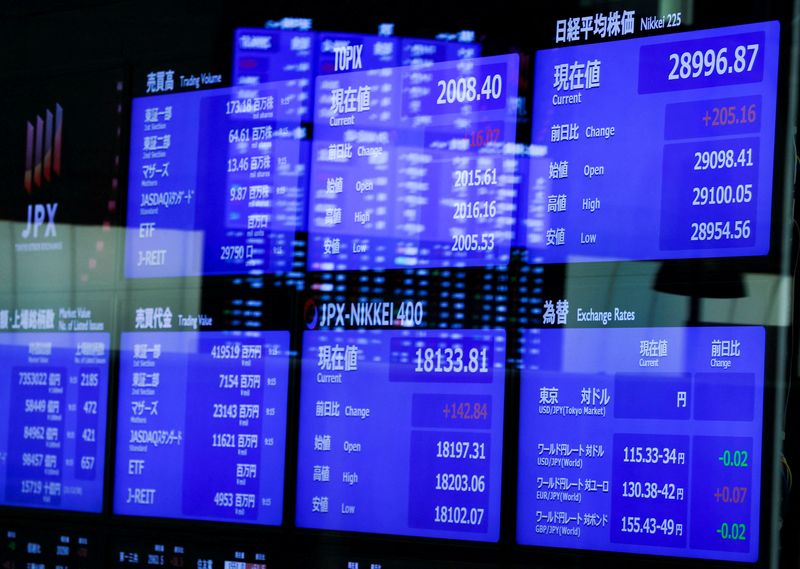

© Reuters. FILE PHOTO: Monitors displaying the stock index prices and Japanese yen exchange rate against the U.S. dollar are seen after the New Year ceremony marking the opening of trading in 2022 at the Tokyo Stock Exchange (TSE), amid the coronavirus disease (COVI
By Tom Westbrook and Xie Yu
SINGAPORE (Reuters) – Global stocks tumbled while safe-havens rallied and oil surged on Tuesday as Europe’s eastern flank stood on the brink of war after Russian President Vladimir Putin ordered troops into breakaway regions of eastern Ukraine.
MSCI’s broadest index of Asia Pacific shares outside Japan skidded 1.44%, dragged down by markets in Hong Kong and mainland China. shed 2%.
fell 1.5%, Nasdaq futures lost 2.2%, and the Russian rouble briefly touched an 18-month low in early Asia trade on Tuesday, after Russia’s MOEX equity index had fallen 10.5% the day before.
In contrast, futures rose 2% to $97.21, touching a new seven-year high on worries Russia’s energy exports could get disrupted, and hit a new six-month top of $1,911.56. [GOL/]
Putin on Monday recognised two breakaway regions in eastern Ukraine as independent and ordered the Russian army to launch what Moscow called a peacekeeping operation into the area, upping the ante in a crisis that could unleash a major war.
A Reuters witness saw columns of military vehicles including tanks early Tuesday on the outskirts of Donetsk, the capital of one of two breakaway regions, and Putin signed treaties with leaders of the two breakaway regions giving Russia the right to build military bases.
Washington and European capitals condemned the move, vowing new sanctions. Ukraine’s foreign minister said he had been assured of a “resolute and united” response from the European Union.
However, a Biden administration official said Russia’s move did not as yet constitute a “further invasion” that would trigger a broader sanctions package, as it was not a departure from what Russia had done already.
Following Russia’s latest move “we are much closer to military intervention, which of course is going to drive a lot of the risk off sentiment in the markets,” said Carlos Casanova, senior Asia economist at UBP, adding the short term volatility in markets caused by both geopolitical factors and the U.S. Federal Reserve was ‘relentless’.
Casanova said the consequences would be higher oil prices, an equity sell off, and people flocking to safe haven assets like the Japanese yen.
In Hong Kong, shares of Russian aluminium producer OK Rusal plunged as much as 22.1% to HK$6.18, their biggest daily percentage decline since April 2018.
Away from Russia, and not helping the Hong Kong market, Hong Kong-listed Chinese tech stocks fell 2.25%, with heavyweights Tencent and Alibaba (NYSE:) both hit by speculation about a new wave of regulatory scrutiny.
In currency markets, the yen rose as much as 0.2% in Asia to a nearly three-week high of 114.50 per dollar, before paring its gains.
The euro fell 0.1% to a one-week low of $1.1296
“In these circumstances, risk metrics are the driving force,” said NAB head of foreign exchange strategy, Ray Attrill.
The nerves also drove U.S. Treasury yields lower, with benchmark 10-year Treasury yields diving as much as 5.5 basis points to 1.8715%. Bets on Federal Reserve rate hikes also eased and the chance of a 50-bp hike next month fell below 1-in-5.
U.S. policy makers have been sparring publicly about how aggressively to begin tightening.
Federal Reserve Governor Michelle Bowman said on Monday that she will assess incoming economic data over the next three weeks in deciding whether a half percentage point interest rate rise is needed at the central bank’s next meeting in March.